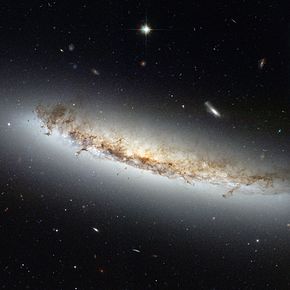NGC 4402
| NGC 4402 | |
|---|---|
 Hubble image of NGC 4402 | |
| Observation data (J2000 epoch) | |
| Constellation | Virgo |
| Right ascension | 12h 26m 07.566s[1] |
| Declination | +13° 06′ 46.06″[1] |
| Redshift | 0.000774[2] |
| Heliocentric radial velocity | 232[2] |
| Distance | 48.38 ± 13.37 Mly (14.833 ± 4.098 Mpc)[2] |
| Group or cluster | Virgo Cluster |
| Apparent magnitude (B) | 12.55[3] |
| Characteristics | |
| Type | (d)Sc[3] |
| Size | 55,000 ly (17,000 pc)[4] |
| Apparent size (V) | 2.967' × 0.593'[1] |
| Notable features | Edge-on spiral galaxy near Markarian's Chain |
| Other designations | |
| UGC 7528, MCG+02-32-044, PGC 40644, VCC 873[3] | |
NGC 4402 is a relatively near, edge-on spiral galaxy located around 50 million light-years from Earth. It is in the constellation of Virgo within the Virgo Cluster of galaxies. It can be seen when viewing Markarian's Chain.
NGC 4402 is roughly 55 thousand light-years wide and is moving away from Earth at around 232 kilometers per second. It is falling into the Virgo galaxy cluster. Images show evidence that the material it once contained to enable it to form stars has been stripped away in a process known as "ram-pressure stripping". This is due to NGC 4402's cooler gasses being struck by hot x-ray gasses coming from the middle of the Virgo galaxy cluster as it moves toward it. The evidence is as follows:[5][6] [7]
- There is apparent truncation of the NGC 4402's dust disk.
- An upward bowing of the dusty disk is apparent. This is caused by a wind of hot gas.
- Light coming from the far side of the stellar disk appears dim and reddish. This may be because pressure coming from the cluster gas is being forced between the disk and the observer.
- The bottom part of the main disk shows dust in the form of linear filaments. These are being ablated in a characteristic "outside-in" manner.
The supernova SN 1976B was observed in NGC 4402 in 1976.[6][7]
Gallery
-
NGC 4402 and other galaxies viewed through the Burrell Schmidt telescope. The black circles were put there to remove bright, foreground stars.[8]
-
NGC 4402 visible in an image of Markarian's Chain. Click the image then move the cursor over it to reveal the location of NGC 4402.
-
NGC 4402 with color rendering
References
- ^ a b c Skrutskie, M. (2006). "The Two Micron All Sky Survey (2MASS)". The Astronomical Journal. 131 (2): 1163–1183. Bibcode:2006AJ....131.1163S. doi:10.1086/498708.
- ^ a b c "NED results for object NGC 4402". National Aeronautics and Space Administration / Infrared Processing and Analysis Center. Retrieved 3 February 2017.
- ^ a b c "NGC 4402". SIMBAD. Centre de données astronomiques de Strasbourg.
- ^ Courtney Seligman. "New General Catalog Objects: NGC 4400 - 4449". Retrieved 3 February 2017.
- ^ "National Optical Astronomy Observatory". noao.edu. Retrieved 4 October 2015.
- ^ a b "NGC 4402, an edge-on spiral galaxy in Virgo - Anne's Astronomy News". annesastronomynews.com. Retrieved 4 October 2015.
- ^ a b "NOAO Press Release 04-06: Galaxy Cleaned Out by Encounter with Hot Cluster Gas". noao.edu. Retrieved 4 October 2015.
- ^ Eso.org. "Messier 87 in the Virgo Cluster". www.eso.org. Retrieved 4 October 2015.
Further reading
- Crowl, Hugh H.; Kenney, Jeffrey D. P.; van Gorkom, J. H.; Vollmer, Bernd (2005). "Dense Cloud Ablation and Ram Pressure Stripping of the Virgo Spiral NGC 4402". The Astronomical Journal. 130 (1): 65–72. arXiv:astro-ph/0503422. Bibcode:2005AJ....130...65C. doi:10.1086/430526.
- Bregman, J. N.; Roberts, M. S. (October 1990). "H I in the giant elliptical galaxy NGC 4406". Astrophysical Journal. 362: 468–472. Bibcode:1990ApJ...362..468B. doi:10.1086/169284.
- Vaucouleurs, G. DE; Vaucouleurs, A. DE; Odewahn, S. (April 1981). "Photometric and spectroscopic observations of SN 1976b in NGC 4402". Publications of the Astronomical Society of the Pacific. 93 (552): 181–189. Bibcode:1981PASP...93..181D. doi:10.1086/130802. JSTOR 40677743.
{{cite journal}}: Unknown parameter|last-author-amp=ignored (|name-list-style=suggested) (help) (subscription required)

![NGC 4402 and other galaxies viewed through the Burrell Schmidt telescope. The black circles were put there to remove bright, foreground stars.[8]](http://upload.wikimedia.org/wikipedia/commons/thumb/d/d3/ESO-M87.jpg/234px-ESO-M87.jpg)

